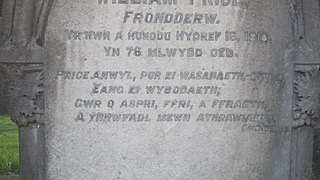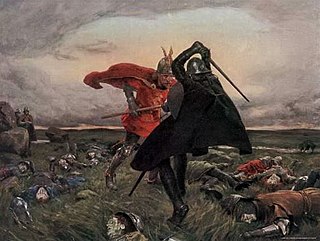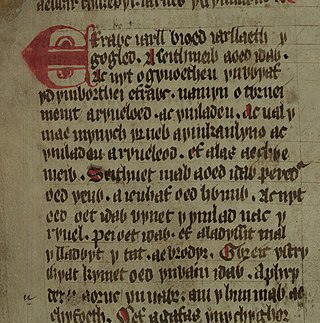Related Research Articles
Lleu Llaw Gyffes is a hero of Welsh mythology. He appears most prominently in the Fourth Branch of the Mabinogi, the tale of Math fab Mathonwy, which tells the tale of his birth, his marriage, his death, his resurrection and his accession to the throne of Gwynedd. He is a warrior and magician, invariably associated with his uncle Gwydion.
Modron ("mother") is a figure in Welsh tradition, known as the mother of the hero Mabon ap Modron. Both characters may have derived from earlier divine figures, in her case the Gaulish goddess Matrona. She may have been a prototype for Morgan le Fay from the Arthurian legend.
Dylan ail Don is a character in the Welsh mythic Mabinogion tales, particularly in the fourth tale, "Math fab Mathonwy". The story of Dylan reflects ancient Celtic myths that were handed down orally for some generations before being written down during the early Christian period by clerics. The story as it has been preserved therefore exhibits elements and archetypes characteristic of both Celtic pagan and Christian mythologies. His name translates as "Dylan the Second Wave."

Bedivere is one of the earliest characters to be featured in the legend of King Arthur, originally described in several Welsh texts as the one-handed great warrior named Bedwyr Bedrydant. Arthurian chivalric romances, inspired by his portrayal in the chronicle Historia Regum Britanniae, portray Bedivere as a Knight of the Round Table of King Arthur who serves as Arthur's marshal and is frequently associated with his brother Lucan and his cousin Griflet as well as with Kay. In the English versions, Bedivere notably assumes Griflet's hitherto traditional role from French romances as the one who eventually returns Excalibur to the Lady of the Lake after Arthur's last battle.

Englyn is a traditional Welsh and Cornish short poem form. It uses quantitative metres, involving the counting of syllables, and rigid patterns of rhyme and half rhyme. Each line contains a repeating pattern of consonants and accent known as cynghanedd.

The Battle of Camlann is the legendary final battle of King Arthur, in which Arthur either died or was fatally wounded while fighting either alongside or against Mordred, who also perished. The original legend of Camlann, inspired by a purportedly historical event said to have taken place in the early 6th-century Britain, appears only in vague mentions found in several medieval Welsh texts dating since around the 10th century. The battle's much more detailed depictions have emerged since the 12th century, generally based on that of a catastrophic conflict described in the pseudo-chronicle Historia Regum Britanniae. The further greatly embellished variants originate from the later French chivalric romance tradition, in which it became known as the Battle of Salisbury, and include the 15th-century telling in Le Morte d'Arthur that remains popular today.

The Kingdom of Powys was a Welsh successor state, petty kingdom and principality that emerged during the Middle Ages following the end of Roman rule in Britain. It very roughly covered the northern two-thirds of the modern county of Powys and part of today's English West Midlands. More precisely, and based on the Romano-British tribal lands of the Ordovices in the west and the Cornovii in the east, its boundaries originally extended from the Cambrian Mountains in the west to include the modern West Midlands region of England in the east. The fertile river valleys of the Severn and Tern are found here, and this region is referred to in later Welsh literature as "the Paradise of Powys".

Peredur is the name of a number of men from the boundaries of history and legend in sub-Roman Britain. The Peredur who is most familiar to a modern audience is the character who made his entrance as a knight in the Arthurian world of Middle Welsh prose literature.
Morfran is a figure in Welsh mythology. Usually portrayed as a warrior under King Arthur, he is noted for the darkness of his skin and his hideousness. He appears in the narratives about the bard Taliesin and in the Welsh Triads, where he is often contrasted with the angelically handsome Sanddef.
In some old Welsh texts, Eliwlod is a nephew of King Arthur. His father is Madoc, son of Uther Pendragon, an obscure brother of Arthur's mentioned a very few times in Welsh literature.
Geraint son of Erbin is a medieval Welsh poem celebrating the hero Geraint and his deeds at the Battle of Llongborth. The poem consists of three-line englyn stanzas and exists in several versions all in Middle Welsh. The earliest surviving version is in the Black Book of Carmarthen, completed around 1250, though the poem may have been composed in the 10th or 11th century. The poem is significant for its early mention of King Arthur.
Cynddylan, or Cynddylan ap Cyndrwyn was a seventh-century Prince of Powys associated with Pengwern. Cynddylan is attested only in literary sources: unlike many kings from Brittonic post-Roman Britain, he does not appear in the early Welsh genealogies or other historical sources. The son of King Cyndrwyn, Cynddylan is described in the probably seventh-century poem Marwnad Cynddylan and seems to have been a chieftain in Powys.
Madog ap Gwallter was a medieval Welsh language poet.

King Arthur's family grew throughout the centuries with King Arthur's legend. Many of the legendary members of this mythical king's family became leading characters of mythical tales in their own right.

King Arthur's messianic return is a mythological motif in the legend of King Arthur, which claims that he will one day return in the role of a messiah to save his people. It is an example of the king asleep in mountain motif. King Arthur was a legendary 6th-century British king. Few historical records of Arthur remain, and there are doubts that he ever existed, but he achieved a mythological status by High Middle Ages that gave rise to a growing literature about his life and deeds.
The Englynion y Beddau is a Middle Welsh verse catalogue listing the resting places (beddau) of legendary heroes. It consists of a series of englynion, or short stanzas in quantitative meter, and survives in a number of manuscripts. The collection is thought to be considerably older than its earliest manuscript, the 13th-century Black Book of Carmarthen, and provides an important early glimpse at medieval Welsh heroic tradition and topographical folklore.
Gwrhyr Gwalstawd Ieithoedd; "Gwrhyr, Interpreter of Languages" is a hero and shapeshifter of early Welsh literature and mythology and a warrior of King Arthur's court at Celliwig. He appears most prominently in the early Arthurian tale Culhwch and Olwen, in which he is handpicked among Arthur's knights to accompany Culhwch on his quest to win Olwen.
In Welsh tradition, Hueil mab Caw was a Pictish warrior and traditional rival of King Arthur's. He was one of the numerous sons of Caw of Prydyn and brother to Saint Gildas.

"To the Yew Tree Above Dafydd ap Gwilym's Grave" is a 14th-century Welsh-language poem in the form of a cywydd, and is usually seen as either an elegy written after the death of Dafydd ap Gwilym or a mock-elegy addressed to him during his lifetime. Its author, Gruffudd Gryg, also wrote another elegy or mock-elegy on his friend Dafydd, and conducted a controversy in verse with him in which Dafydd's poems were criticised and defended. The cywydd on the yew tree constitutes the main evidence for the widespread belief that Dafydd is buried at Strata Florida Abbey in Ceredigion. It has been called "a superb poem, perhaps Gruffudd Gryg's best...a remarkably sensitive and perceptive act of poetic homage that acknowledges, far more than any more direct statement ever could, Dafydd's status as a true athro for his generation". It was included in both The Oxford Book of Welsh Verse and The Penguin Book of Welsh Verse.
References
- ↑ "The death-song of Madawg"
- ↑ Miss Russell. "Notes on Welsh Legend", History of the Berwickshire Naturalists' Club, Volume 11, 1887
- ↑ Jones, Nerys Ann (12 July 2019). Arthur in Early Welsh Poetry. Library of Medieval Welsh Literature. p. 177. ISBN 9781781889084.
- ↑ "Dialogue of Arthur and Eliwlod"
- ↑ "Englynion y Beddau"
- ↑ Jones 2019, pp. 101, 107.